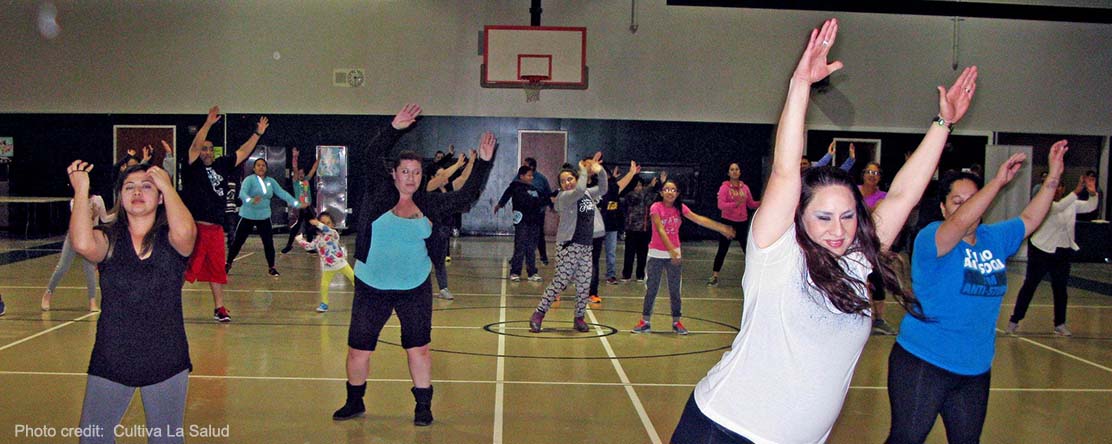
In the News
Sharing Public Spaces to Improve Public Health
-
Focus Areas
Chronic Disease Prevention, Healthy Communities -
Programs
Cultiva La Salud/Central California Regional Obesity Prevention Program

As a farmworker in Orange Cove, one of California’s most impoverished cities, Lorena Gomez starts her day just past dawn, teetering on a ladder to pluck fruit and place it in a canvas sack that weighs heavily across her chest.
Despite this grueling work, Gomez, a 31-year-old single mother, manages to drum up the energy twice a week to attend an evening Zumba class at a local middle school, her 10-year-old daughter, Katelyn, often twirling by her side on the dance floor. “You go to the fields, cook, clean, take a quick shower and then you go to Zumba,” Gomez said of her routine, which has helped her lose 30 pounds and “made me feel more pretty,” she added. “The Zumba relaxes me.”
The Zumba class in Orange Cove, a largely Latino community encircled by citrus fields in the Central Valley, is the result of an increasingly significant practice known as “shared use,” also called “joint use” or “community use.” Shared use is a legal or informal agreement in which a school, church or similar institution opens its doors to the public for health-related activities, typically spearheaded by a city or a nonprofit. The concept is particularly compelling in poor urban and rural areas where safe and accessible parks are few and gym memberships are beyond financial reach for many.
“We’re not installing Planet Fitness or Lifetime Fitness anytime soon,” said Erika Hood, the community health engagement coordinator at the Case Western Reserve University School of Medicine’s Prevention Research Center in Cleveland. “So how do we use existing neighborhood spaces for physical activity?”
Though not yet ubiquitous, the idea of unlocking school gates on weekends or for free evening Zumba classes is gaining traction as a relatively inexpensive “place-based approach to health equity,” according to Benjamin D. Winig, vice president for law and policy at ChangeLab Solutions, which provides legal and technical assistance on public health issues.
Over the past few years, these slightly wonky but effective agreements have helped the National Tongan American Society in Salt Lake City offer hula and Zumba classes in Mormon cultural halls and inspired “Food for the Soul,” a healthy cooking class in a school cafeteria in East Cleveland, in which parents master fattoush salad and other guilt-free recipes while being serenaded by soul tunes.
In Orange Cove, poor air quality and triple-digit summer temperatures can make outdoor activities dangerous, said Genoveva Islas, program director for Cultiva La Salud — “cultivate health” in Spanish — a nonprofit in Fresno that works on access to healthy foods and recreation in the Central Valley, a region with high rates of diabetes, heart disease and obesity. Gang activity has made use of the city’s lone bike trail a precarious proposition and amenities like parks and street lighting are limited. “It’s a deficit that perpetuates inactive lifestyles and therefore poor health,” Islas said.
Through a grant from the Centers for Disease Control and Prevention, her organization jump-started a deal with the city and the school district to make schools available for the evening Zumba classes. The district agreed to pay the extra custodial time while the city sprang for liability insurance.
“A major part of this is education,” said Victor P. Lopez, the city’s mayor, a diabetic who beat back dialysis by walking three miles a day and changing his preferred diet of fried pork rinds, pulled pork carnitas and at least 10 flour tortillas a day, he said. “The men love soccer big time,” he added. “We needed something for the ladies.”
Shared use agreements have been proliferating over the past decade, spurred by obesity and other chronic diseases, diminishing green space, and new research that links health to the man-made environment, said Jeff Vincent, deputy director for the Center for Cities and Schools at the University of California, Berkeley. The C.D.C.’s recommended 60 minutes a day of physical activity for children and adolescents has also inspired schools to think beyond physical education.
Although nobody tracks exact numbers, a 2012 survey by the C.D.C. found that out of 630 school districts that responded, 61 percent reported some form of shared use, with large Western urban school districts the most enthusiastic adopters. Promoting community health and other programs through shared use “may be an untapped resource” for schools, the survey suggested.
Nevertheless, making it happen isn’t always easy. The story of the Burroughs Elementary School in Fresno, where a group of parents rallied to the shared use cause only to see their efforts shelved after a yearlong pilot program, is a cautionary tale, albeit one with a happy ending.
Susana Cruz, a 36-year-old mother of three, started a campaign to unlock the gates after school and on weekends because the closest park for children in southeastern Fresno, an area of concentrated poverty, was more than two miles away. Neighborhood children would routinely jump the school fence to play basketball or climb on the monkey bars. “Some parks were not well maintained and unsafe for our children to go to,” Cruz recalled. “Having the school gates unlocked was an immediate solution to our needs and one that we felt safe using.”
The parents, all volunteers, made an informal arrangement with the school in which each adult took responsibility for a specific time slot to monitor the playground, passing the key back and forth. But reports of vandalism and the difficulty of handing off the key caused the school district to pull the plug. “That was frustrating,” said Carlos Castillo, Burroughs’s principal at the time. “We wanted this to be a good thing.”
The pilot ended, but the idea stuck. Six years later, shared use has been embraced big time by Fresno, which was eager to escape its ranking as one of the nation’s most park-poor cities. While the Burroughs pilot was based on an informal agreement with parents, the city initiative involved an investment of $1.2 million to open up playgrounds and other green spaces at 16 school sites on weekends; those spaces now offer organized fitness, sports, yoga and nutrition classes led by student-mentors from Fresno State University alongside grassy fields for picnicking and other activities. The partnership has been so successful that last summer, seven high school pools were opened up to public use and — no shock here — they were packed all season long.
Historically, the biggest hurdle to shared use, especially for schools, is concern over liability, which frequently becomes “a nine-letter word for ‘no,’” Winig said. Yet schools, he noted, are already under a legal obligation to safely maintain playground equipment and other facilities. “A school doesn’t suddenly become unsafe when the school bell rings,” he pointed out. All states have laws that either fully or partly protect school districts from liability based on a negligence claims, he added.
A common scenario is a swap in which a city will indemnify a school in exchange for the school opening its gates for community use, resulting in “a new park that’s been sitting there all along — taxpayer paid,” Winig said.
The concept also extends to rural churches, making fitness part of the lifeblood of these community staples along with meetings, weddings and funerals. At the First Missionary Baptist Church in Concord, N.C., Theoma Southwell, the parish nurse, worked with the county health alliance to include a mile-long walking trail and a fitness class for older people. “ If you don’t feel well physically you won’t feel well spiritually,” Southwell observed. “They all go together.”
Originally published by The New York Times
More Updates
Work With Us
You change the world. We do the rest. Explore fiscal sponsorship at PHI.
Support Us
Together, we can accelerate our response to public health’s most critical issues.
Find Employment
Begin your career at the Public Health Institute.



